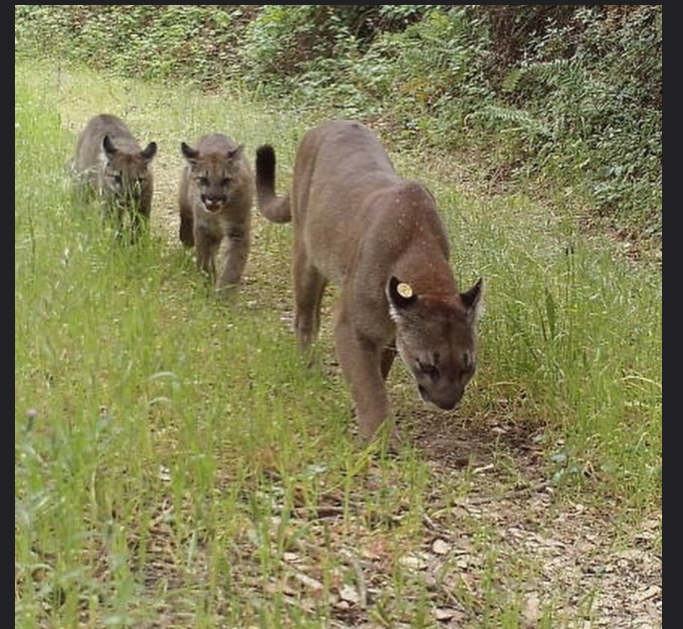COURTESY // @pressdemocrat on Instagram
Mountain Lions were seen this year on dozens of motion sensor cameras in North Bay.
If you drive only 20 minutes south of Rohnert Park you’ll see stretches of farmland and open pasture inhabited by cows, goats, and other livestock. However, Sonoma County is also home to other wildlife that some visitors might be less eager to experience up close. Mountain lions, bears, vultures, and more also call Sonoma County’s landscape home. They inhabit Taylor Mountain, less than five miles from Sonoma State’s campus, and Trione-Annadel Park, just 14 miles away.
On occasions, this wildlife makes its way onto Sonoma State’s campus or in the surrounding towns. Last year, a female mountain had to be removed from roaming around near schools in Rohnert Park, and only last week there was a bear walking around downtown Petaluma. In an area teeming with animals, Sonoma County residents must remain informed about the behaviors of Sonoma County’s wildlife and be prepared for interactions.
Annie Fanelli, a resident of Rohnert Park since 2020, has only recently been surrounded by the wildlife that she now finds herself preparing for a glimpse of. While she’s lived in areas surrounded by farmland and mountains before, this past year was the first time she heard about wildlife getting quite so close. Fanelli heard firsthand that a mountain lion came only steps away from her backyard. However, despite this, she has maintained that the best defense against a possible mountain lion by your home is a greater understanding.
“I have no problem with ‘so-called’ wild animals- we’re in their territory,” Fanelli said.
Fanelli’s animal-loving philosophy has kept her calm and fascinated by animals moving into new areas or sightings. She believes that understanding animal behavior is key to safety.
“Situational awareness is what’s going to keep you safe,” Fanelli advised. She stressed the importance of understanding the behaviors of the wildlife around your area in order to feel safe and not panicked by the news of a wild animal strolling down your sidewalk.
A similar philosophy is shared and spread by Dr. Quinton Martins, a Big Cat expert, conservationist, and Partner at Sonoma County’s True Wild. He has been studying mountain lion behavior and other wildlife for over 25 years.
Martins said that Sonoma State “is not in the core mountain lion area,” and, if anything, mountain lions may “move along the creek,” as he explained how younger mountain lions may use creeks as pathways. For most cases, however, mountain lions choose to move around people, avoiding them whenever possible. While this is their territory there are only a few mountain lions with established territory in the area and their behavior shouldn’t lead them into densely populated areas. He stressed multiple times that mountain lions in this area seek to avoid people.
“You would be amazed,” Dr. Martins said, “if you overlaid GPS from hikes and mountain lions, how close you’ve come.”
While this idea may seem startling, the one biggest take-away from Dr. Martin’s explanation of mountain lion behavior is that they are “doing everything they can not to be detected.”
Last week in Petaluma, a black bear was spotted walking around near Petaluma Golf and Country Club before climbing into a redwood tree, as reported by the Santa Rosa Press Democrat.
“Really the best thing to do is just give thanks, back off, and let the bear do what it does,” said Meghan Walla-Murphy, a wildlife ecologist, tracker and independent consultant, to the Press Democrat.
These experiences of black bears coming into populated areas seem to be on the rise as their populations rise and they move into new territories.
In compliance with new federal and CSU procedures, Sonoma State has recently updated its safety protocols around animals on campus in a memo that went out Nov. 17.
“On November 10, 2021, a revised Animals on Campus policy went into effect at Sonoma State University. Risk Management and Safety Services has been working to align SSU policies with CSU systemwide procedures and policies to ensure compliance and reduce risk..[and] to ensure equity and compliance with new federal and state guidelines,” read the mass email sent out to campus.





![[Both photos courtesy of sonoma.edu]
Ming-Ting Mike Lee stepped in as the new SSU president following Sakakis resignation in July 2022](https://sonomastatestar.com/wp-content/uploads/2024/04/CC4520AB-22A7-41B2-9F6F-2A2D5F76A28C-1200x1200.jpeg)


























